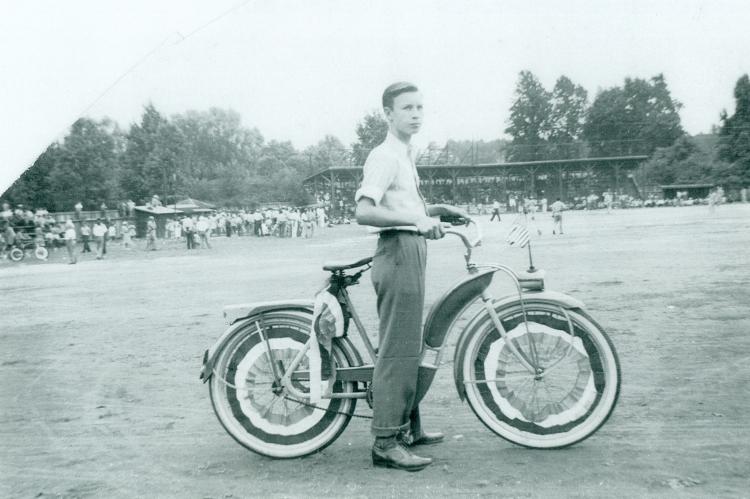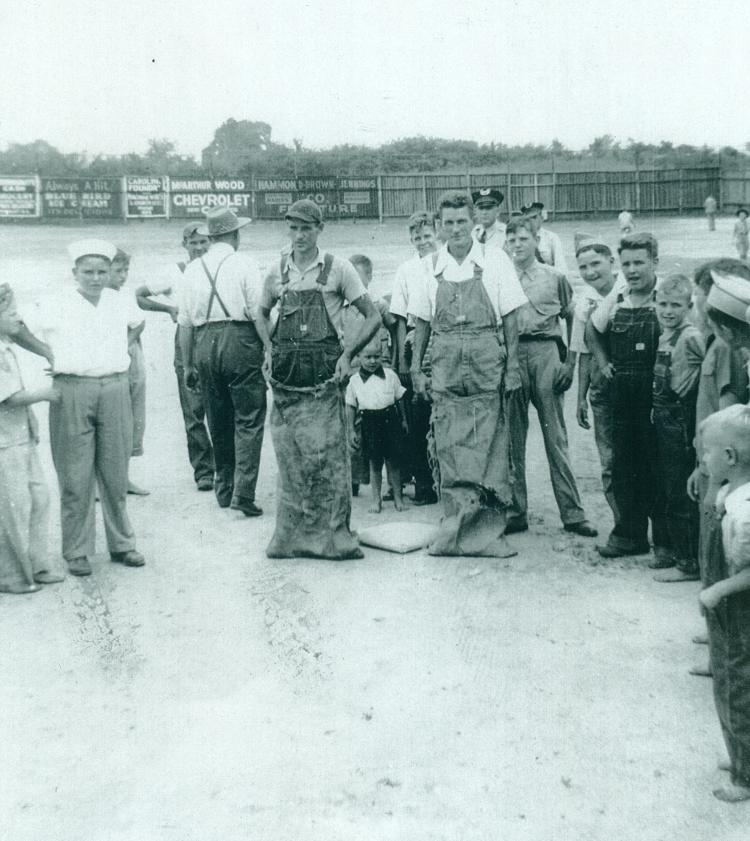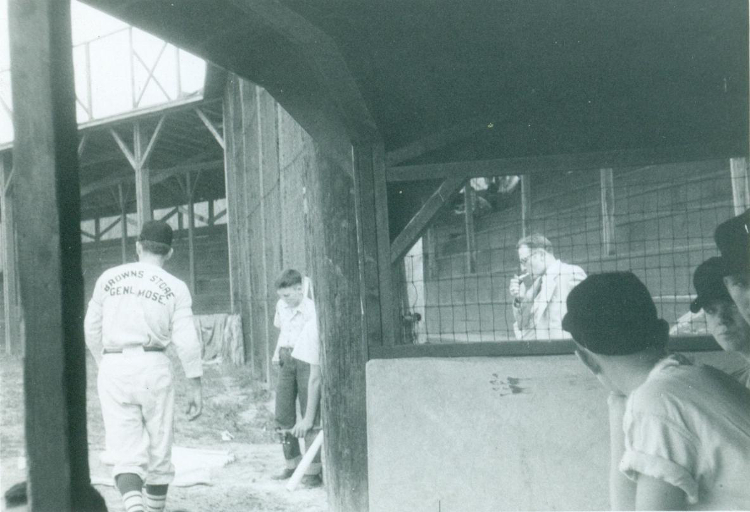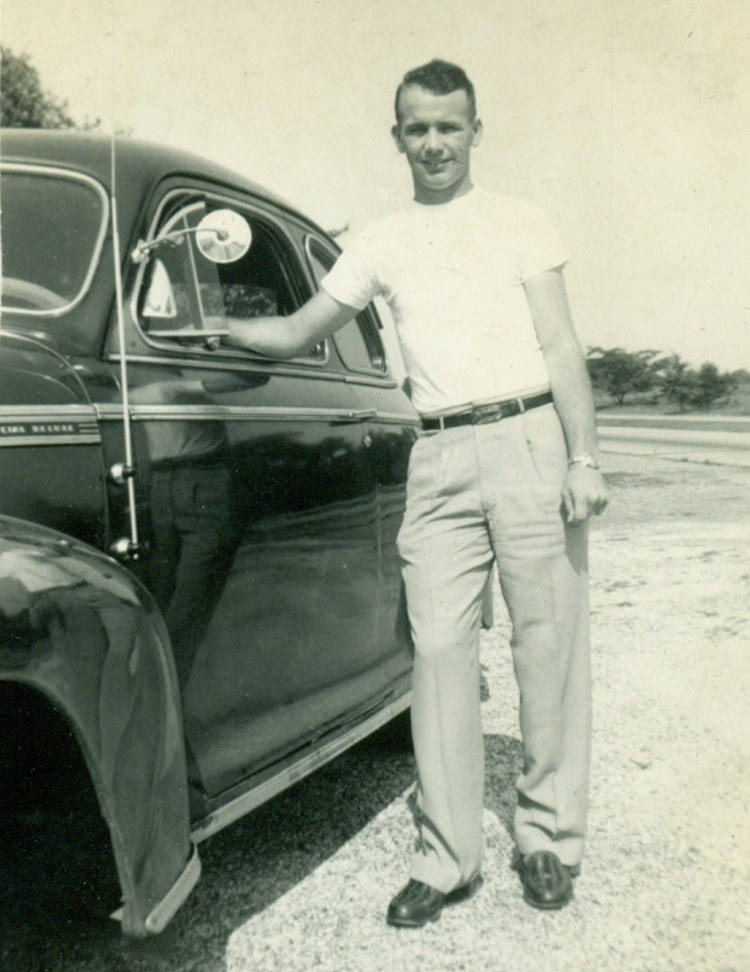Pacolet Mills Baseball Park
One of the most important places to the Pacolet Community during the 1940’s and 50’s was the Baseball Park. It was the home of the Pacolet Trojans baseball teams, both Black and White. It was at the end of Brewster Street right beside the Dummy Line Railroad tracks. I’m not sure when it was built but I think it was sometime during the 1930’s.
The ballpark itself was large. The distance to the fence in left, right and center field was probably close to that of major league fields of today.
The main feature of the park, besides the playing field, was the large wooden grandstand. This was an enclosed structure behind home plate with maybe 8 to 10 elevated rows. The front of the grandstand was covered with wire screen to protect the spectators from foul balls.The grandstand is shown in the background of this Fourth of July photo made about 1948 or 49 of an unidentified boy with his bicycle. He is in right field of the ballpark and the grandstand is in the distance. The home team dugout is to the right of the grandstand.This picture shows the size of the crowd that attended.
Another view of the grandstand is this photo of Pacolet Mills Girl Scout Troop 17, and a few boys, standing in front of it.This picture was made about 1953.
The entire park was surrounded by a high wooden fence. The fence around the outfield was built differently than that around the rest of the park. There was a sloping dirt bank that was probably 4or 5 feet higher than the level of the playing field. The fence, about 8 feet high, was built on top of this bank. The way the fence was made meant that an outfielder had to play long fly balls differently than in most parks. When chasing a ball, he encountered the slope to the fence 10 feet or so from the fence. To get to the ball he had to run up this slope. This slope was probably a confusing factor to the outfielders of visiting teams. Part of the outfield fence and slope up to it is shown in the photos below. Notice that the fence was mostly covered with signs of local companies advertising their business. My Dad, Fred "Doog" Teaster, had a sign on this fence advertising his well drilling business. The first photo shows contestants in a fourth of July sack race with the fence in the background.We don't know if it is before or after the event. This picture was taken from around the third baseline looking towards right field. The man on the right, in the sack, is Wade Sullivan. Mr. Herb Jones, the Pacolet policeman, is standing toward the back, on the right side. More photos of the ballpark are shown in Album No. 9 - More About Baseball.
A closer look at the fence and the slope going up to it is in this photo of the Girl Scouts raising the flag on a pole in center field in about 1953.
There were long uncovered bleachers built along both the first and third baselines in the late 1940’s. There were probably 10 rows or so and they had no shade from the sun. They also did not have a wire screen to protect against foul balls. If you sat in these bleachers you had to pay attention to the game or risk being hit with one of the frequent foul balls.
There were two covered concrete “dugouts” for the players. The home team dugout was on the third base side and the visitors on the first base side. The photo below was made from inside the home team dugout looking toward the grandstand.
There was a concession stand located behind the first base bleachers that sold soft drinks (“dopes”), candy, etc. If I remember correctly, Mr. Brownie Trent ran the stand during regular Pacolet Trojan games. I think, also, that he was the manager of the YMCA (The Hall). The concession stand was a popular place with all the young boys.
It is believed that the following photograph was made just after WWII around 1946 or 1947. The background gives some clues as to its age. The picture was taken before the bleachers along the first and third baselines were built and lights installed for night games. Spectators watch a "pick up" baseball game before the regular teams play. It appears that one of the regular teams is in uniform in the visitor's dugout waiting to play. This photo was taken from left field in foul territory looking towards home plate and the grandstand. The dugout shown was replaced when the new bleachers were built. Also, the scoreboard shown on the extreme left was replaced with one on the fence in center field at about the same time.
The main entrance and ticket office for the park was at the end of the first base line and the end of Brewster Street. There was a parking lot just off Brewster St. beside the outfield fence. Upon entering the gate at the ticket office you were actually in a grove of big oak trees. These covered the area almost all the way to the end of the first base bleachers. The shady area under these trees was a popular place in the summer time even if no games were being played. There were several horse shoe pits and “stobs” that had frequent players. I remember that there were several men that played that were extremely good. If you played with them and did not throw a ringer almost every throw you would likely get beat.
Another wonderful use for the area under the trees was cooking the barbecue for the annual Fourth of July Celebration. Long pits were dug under the trees and entire hogs would be cooked over the coals in the pits. Also, huge iron pots of hash would be cooked to be served with the barbecue on the fourth. This cooking took place the night before the Fourth and you could smell the appetizing scent for a long distance away. You can read more about the celebration by clicking on Pacolet Fourth of July. You can also see more photos about the celebration by clicking on Photo Album 7.
For a long time, all of the games had to be played in the daytime. However, after WWII, about 1948, lights were installed around the park. These were not lights on short poles that you see today on softball fields or playgrounds. These were some serious “Industrial Strength” towering poles that held powerful lights. The poles must have been 70 or 80 feet high. You can see photos of the lights and the ball park at Photo Album 9.
The following photograph was taken from in front of the home team dugout looking out to right field. Notice the tall light pole on the left. This picture also shows the grove of trees just behind the ticket booth. The score board can be seen in right center field where it was moved at about the time the lights were installed.
I remember an occurrence one night during one of the Pacolet Trojan games that involved the lights. The lights on the poles were connected by an electric line that ran between them almost at the top of the poles. The wire was a long way off the ground, maybe 60 feet or so. The wire that was the farthest from home plate ran between 2 poles in left center field. Mr. Red Ellison was the center fielder for the Trojans and a powerful hitter. One night, Red came up to bat and hit an incredible home run. The towering hit struck this cable between the poles in left center. This would have been a home run in any Major League Park and probably would have gone completely out of the stadium in many of them. It was an awesome display of power hitting.
During the Trojan games there was something that happened that for some of the fans caused almost as much excitement as the game itself. There were frequent foul balls that went over the grandstand. Every one of these generated a wild scramble by a pack of boys - and sometimes men - to recover it. The area behind the grandstand had trees and a small creek and was well lighted. There was usually a free for all for the ball. Evidently, the scramble for the ball was just for sport because the recovered ball had to be returned to the Trojan's dugout.
Other Uses for the Park
At about the same time that the lights were put in place in the park, organized youth baseball came to Pacolet. I think that today it would be called the Little League but it was not called that then. The teams practiced and played in the ballpark. The mill company, Pacolet Manufacturing Company, paid for this program and for the coaches. As far as I can remember, the first coach for the youth teams was Mr. James "Pee Wee" Lambert. I think at the time he was still a student at Wofford and had also just started playing for the Pacolet Trojans as a catcher. My brother, "Dink", and I and several of our friends played in this program for a few years. We sometimes traveled to other towns, such as Woodruff, to play their team. One of my teammates during this time was George Banks who went on to play in the major leagues.
We were fortunate to have Mr. Lambert for our coach. He taught us about many things other than baseball such as sportsmanship. He had infinite patience with us. I never once heard him raise his voice and scream at us in the way that seems common with coaches of youth teams today. Involvement in the youth baseball program was just the beginning of his many years of service to the Pacolet Community. He went on to become the principal of Pacolet High School and was one of the town's first Water Commissioners. The photo below was made about the time he started to be in charge of the youth league in the late 1940's.
The ballpark use was not limited to regular Pacolet Trojan baseball games. Several other groups used it also. Just after the lights were put in about 1948, the Pacolet High School football team played their home games at night in the ball park. Part of the layout for the football field included the baseball infield that had no grass, only hard, packed earth. Tackling and blocking on that hard ground must have been a painful experience. One game I remember seeing there was when the PHS team played the Cedar Springs School for the Deaf. All of the Cedar Springs' signals were done in sign language. This certainly did not seem to slow them down as they trounced the Pacolet home team.
There was actually more at the ballpark that just athletic activity. One of the deep wells that supplied water for the town of Pacolet Mills was located near the end of the third base line.
The ballpark is now only a distant memory. I understand that there is little evidence that it was ever there. But once upon a time, it was a wonderful place and full of excitement for many, many Pacolet people.
This web site has been started as a public service to share the story of Pacolet.





